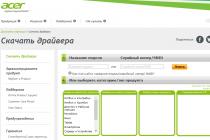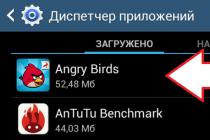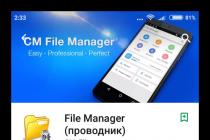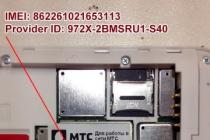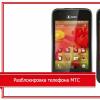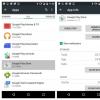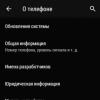Information culture of the teacher
Kochetok Natalya Gennadievna
information culture of the teacherKochetok Natalya Gennadievna, teacher of technology and fine arts, Russia, St. Petersburg, secondary school № 474
Keywords: information culture of the teacher, Information society, specifications information culture, the conditions for the formation of the information culture of the teacher.
keywords: information culture of the teacher, information society, characteristics of information culture, the conditions of formation of information culture of the teacher.
In recent years, considerable attention has been paid to the formation of the information culture of representatives of the pedagogical community: practicing teachers, students of pedagogical universities, etc. This problem is reflected in dissertations, materials scientific conferences, publications in professional pedagogical periodicals.
V professional activity The teacher's ability and desire to find new information, facts, materials, and use them in practical activities is important. This is especially true today, when the time frame for updating information is rapidly decreasing while its volume is growing at the same time. The information society requires the formation of a new type of education, in which learning becomes an integral attribute of a person's entire life. Today, in order to become (and remain) a specialist, it is necessary to constantly acquire new knowledge, not limited to those that were once obtained in an educational institution. The combination of qualities that allow this activity to be carried out effectively indicates a high level of information culture.
The teacher must be able to navigate the ever-growing information flow and instill this ability in his students. And today, in the professional pedagogical environment, the concepts of “information”, “informational”, etc. are widely used. in various guises. At the same time, in our opinion, the essence and place of information culture in the activities of teachers and in the system of pedagogical culture are not clearly defined. Information culture today is a necessary component of pedagogical culture. The teacher today should be ready to use new information technologies, to be able to fully implement the existing information resources, which involves the development of all components of the teacher's information culture. What is information culture? What characteristics does it include, and what are the conditions for its development? This article reveals the main aspects of the formation of the teacher's information culture.
Under information culture is understood as the ability to purposefully work with information (search, selection, creation), use it to receive, process and transmit informatization tools and information technologies. Information culture should be viewed as a complex systemic education reflecting the integration of knowledge about man and the culture of mankind.
The information culture of the teacher includes the following characteristics:
In the intellectual field:
- Thinking (the ability to analyze information resources and identify their capabilities in solving problems of pedagogical activity, to show creativity, flexibility, criticality, consistency, mobility and efficiency of thinking in situations of search, transformation and transformation necessary information);
- Knowledge of information technologies.
- Motivation for the development of information culture (the desire to master modern information technologies, the desire to study the best practices in the field of informatization of education, the focus on achieving high level information culture).
- Purposefulness of actions in the information environment (volitional resolution of contradictions, the ability to perform activities at the optimal level of activity, mental stability in relation to difficulties);
- Patience and self-control in situations of information search, its processing for pedagogical purposes;
- Perseverance in mastering new information technologies.
- The ability to understand one's own emotional states in situations of information search and processing (to focus on the ways and means of obtaining information);
- The ability to adequately survive the lack of results, technical and other obstacles when working in the information environment;
- The ability to adequately assess their own achievements in the use of information technology, their level of information culture.
- The ability to reproduce and master new knowledge, types, forms of activity in the information environment;
- Readiness for collective activity using information technologies;
- Operational skills (ability to work with software make decisions, select necessary information, generate ideas)
- Knowledge of information processing skills;
- Ability to communicate using information media and technologies;
- Ability to navigate in the information environment.
The ability to reflect in the field of information search and transformation, in mastering information technologies and their use;
The ability to correlate their activities, their level of information culture with social and professional experience.
The main conditions for the formation of the information culture of the teacher are:
- Inclusion of a teacher in project activities;
- Organization of independent development by the teacher of various projects and their implementation on the basis of information technology;
- Self-diagnosis and self-analysis of achievements in the field of project activities carried out on the basis of information technology;
- Cooperation with colleagues in project activities.
In the conditions of informatization of education, the general complex of professionally important qualities necessary for the success of professional activity is supplemented by specific qualities that characterize the level of information culture of the teacher. O. N. Mäeots refers to them as follows:
Pursuit:
- interest in modern methods of information exchange and the search for new ways to intensify the educational process on an information basis;
- the need for constant updating of knowledge about the possibilities of using information technologies in a professional and general cultural environment;
- professional mobility and adaptability in the information society.
Personal qualities:
- Responsibility for working with technical means a combination of personal freedom and responsibility for information security society and personality;
- consistency in the formulation and consistent solution of pedagogical problems using information technology tools;
- confidence in the correctness of making non-standard decisions.
Position:
- attitude to information, objects and phenomena in a rapidly changing information environment, a critical attitude to information consumption;
- the style of pedagogical communication and interaction with people within the information environment, self-assessment and reflection at the level of information contacts;
- affirmation of morality and tolerance in computer communication”.
The level of formation of information culture teacher can be determined by the following set of criteria indicators:
1) the state of information self-awareness of the teacher (general cultural and professional erudition; understanding and acceptance of values information activities; reflectivity of professional position; the use of information educational resources for the purposes of self-education; consistency of real activity with values);
2) the development of information technology skills (the use of information technology in solving urgent pedagogical problems; the availability of a flexible system of skills; participation in ensuring information interaction in an educational institution);
3) creative activity and independence (participation in project activities, creation of own information products; presence of an author's position (methodology); ability to make a choice and attract the necessary information resources);
4) emotional attitude to information activity (positive professional self-assessment; presence of interest in information activity; satisfaction with the results of one's own information and pedagogical activity);
5) the success and efficiency of information and pedagogical activities (the presence of achievements in the field of information and pedagogical activities; recognition by the professional community; participation in joint projects with other specialists).
Literature:
- Formation of the information culture of the individual: theoretical justification and modeling of the content of the academic discipline / N.I. Gendina, N.I. Kolkova, G.A. Starodubova, Yu.V. Ulenko - M.: Interregional Center for Library Cooperation. 2006. - S.10-11
- Zubov, Yu.S. Informatization and information culture / Yu.S. Zubov // Problems of information culture: Sat. articles.- M., 1994.- S. 6-11
Appendix
Questionnaire for determining the information culture of a teacher
| № | Criteria | Meter | Points |
|---|---|---|---|
| 1. | Level of ICT competence* | Basic | 1 |
| Teacher-consultant | 2 | ||
| Tutor | 3 | ||
| Research Consultant | 4 | ||
| 2. | Advanced training in the field of ICT in the current academic year - full-time | Yes | 1 |
| Not | 0 | ||
| 3. | Advanced training in the field of ICT in the current academic year - remotely | Yes | 1 |
| Not | 0 | ||
| 4. | Uses in educational process acquired by the CER | Yes | 1 |
| Not | 0 | ||
| 5. | Uses own DER in the educational process | Yes | 2 |
| Not | 0 | ||
| 6. | Replenishes the OU's media library with its own DER | Yes | 1 |
| Not | 0 | ||
| 7. | Uses ICT in additional education and educational work | Yes | 1 |
| Not | 0 | ||
| 8. | Uses ICT in education management (data processing, statistics, electronic journaling, etc.) | Yes | 1 |
| Not | 0 | ||
| 9. | Supervises the research work of students using ICT (availability of projects on the Internet) | Yes | 2 |
| Not | 0 | ||
| 10. | Uses Internet resources in the educational process | Yes | 1 |
| Not | 0 | ||
| 11. | Uses ICT in the preparation of didactic material for students | Yes | 1 |
| Not | 0 | ||
| 12. | The number of lessons that implement the possibility of using Internet resources On-Line (in real time) (per week) | More than one lesson | 2 |
| One lesson | 1 | ||
| There are no such lessons. | 0 | ||
| 13. | The number of lessons in which computer testing(final, intermediate, thematic) (per week) | Three or more lessons | 2 |
| Less than three lessons | 1 | ||
| There are no such lessons. | 0 | ||
| 14. | Number of lessons using interactive, multimedia equipment or digital labs (per week) | Five or more lessons | 2 |
| Less than five lessons | 1 | ||
| There are no such lessons. | 0 | ||
| 15. | Participation in competitions, festivals on the use of ICT | Winner or Laureate | 3 |
| Yes | 2 | ||
| Not | 0 | ||
| 16. | Speech at the MO, teachers' councils, conferences on the exchange of experience in the use of ICT in the educational process | At the federal level | 4 |
| At the regional level | 3 | ||
| At the city level | 2 | ||
| At the school level | 1 | ||
| Not | 0 | ||
| 17. | Availability printed works in ICT |
Yes | 2 |
| Not | 0 | ||
| 18. | Placing materials in online communities | Yes | 2 |
| Not | 0 | ||
| 19. | Having your own Web pages (specify URL) |
3 | |
| 2 | |||
| Yes, but the material is not updated |
1 | ||
| Not | 0 | ||
| 20 | Having your own website (specify URL) | Yes, the material is updated at least once every two months | 3 |
| Yes, but the material is updated less than once every two months | 2 | ||
| Yes, but the material is not updated |
1 | ||
| Not | 0 | ||
| 21. | The use of elements of distance learning for students (learning interaction via e-mail with students who are at home, posting trial versions of independent or control works, lectures or additional materials on your own Web pages, etc.) | Distance learning | 4 |
| Own web pages | 3 | ||
| Online Dnevnik.ru | 2 | ||
| With help Email | 1 | ||
| Not | 0 |
* Defined with " Essential characteristics of the levels of development of ICT literacy of teachers"
** Determined by the availability of the teacher's developments in the media library
Maximum points - 43
- Less than 14 - a weak level of information culture development;
- 15 - 24 - acceptable level of information culture development;
- 25 - 34 - a sufficient level of development of information culture;
- 35 - 43 - the optimal level of information culture development.
Appendix No. 1.4
Tests for diagnosing the level of information culture of a student
6th grade.
Teacher-librarian
Pilipeyko Natalya Petrovna
1) . How do you think? (choose 1 answer)
Society, the level of which is determined to a decisive extent by the quantity and quality of the accumulated and used information, its freedom and accessibility, is:
1. society of new information technologies
2. information society
3. computerized society
2). How do you think? (choose 1 answer)
The totality of the information worldview and the system of knowledge and skills that provide purposeful independent activity to meet individual information needs using both traditional and new information technologies is:
1. library and bibliographic culture
2. computer literacy
3. information culture
4. information literacy
3). Eliminate incorrect rules of behavior in the library ?
1. Keep quiet
2. Talk loudly on your cell phone.
3. Choose books on the shelves carefully and carefully.
4. When using a book in the reading room, it is allowed to make notes and fold the pages.
4). Explain what is a material carrier with fixed information that can be stored and transmitted over time?
(Correct answer: document)
5). How do you think? (choose 1 answer)
A set of web pages designed for exchanging messages with the ability to classify them by topic and save them for later use is called:
1. Forum
2. chat
3. site
6) What search elements will you use for address search (select 1 answer):
2. The theme of the book.
3. Year of publication.
7) How do you think? (choose the correct answers)) The bibliographic description of the document consists of:
2. Titles of the book (article).
4. output.
7 a. Make a bibliographic description of the book/article.
(each is given a book / article in a newspaper (magazine))
8). You can select books on the topic of the abstract given to you with the help of ...?
Explain why.
(systematic catalogue).
9). How do you think? (choose 1 answer)When searching for the necessary information, the words that carry the greatest semantic load in the text are called:
1. keywords.
2. metaphors.
3. synonyms.
10). How will you search for information about ancient libraries?
Write an answer with explanations.
(Visit to the district library to work with the catalog.
via internet)
11). How do you think? (choose 1 answer))
A well-known first printer in the Russian state is:
1. Johannes Gutenberg
2. Timothy Nevezha.
3. Ivan Fedorov
12). How do you think? (choose 1 answer))
A verbatim excerpt from the text of any document is:
1. theses
2. digest
3. quote
thirteen). What is meant by periodicals?
Explain your answer.
1. Magazines
2.Books
3. Articles
14). How do you think? (choose 1 answer)) With the help of the encyclopedia, you can
1. Get full information about the required topic.
2 . Quick reference
15). How do you think? (choose 1 answer)) A systematized list of sections, subsections, characterizing the content, logic and composition of your retelling, abstract, report, etc., is:
1. plan
2. overview
View document content
"Tests "Information culture of personality" grade 5-6"
Information culture of personality
Currently, student testing is widely used to identify the quality of knowledge gained in various subjects. Tests are an effective form of control. This material can be used to diagnose the level of knowledge of students in grades 5-6 in the field of information culture.
Test #1
Choose the correct definition for the word "library":
a) a collection of printed and handwritten materials;
b) an institution in which public use of printed and handwritten materials is carried out.
c) bookkeeping.
Why is the name of the profession "librarian" pronounced and written in the masculine gender:
a) since ancient times, the profession was considered male;
b) in the feminine it sounds ugly;
c) you can pronounce and write as you like.
The first attempt of an ancient man to create a book:
a) knot letter;
b) clay tablets;
c) stone books.
4.B ancient times in Egypt for writing used:
a) birch bark;
b) papyrus;
5. The library of King Ashurbanipal in Assyria consisted of:
a) papyrus scrolls;
b) parchment books;
c) clay tablets
6. The most famous library of antiquity was located:
a) Alexandria, Egypt;
b) the city of Pergamon, Asia Minor;
c) Nineveh, Assyria.
7. The best-preserved version of the book from ancient times:
a) knot letter;
b) clay tablets;
c) papyrus scrolls.
8. Which of the varieties of books used multi-colored cords, patch and knots:
a) stone books
b) knot letter,
c) clay tablets
9. The writing material "parchment" was made from:
b) river reed:
10. What books of antiquity were considered the most expensive, valuable and chained to the shelves with chains:
a) papyrus;
b) parchment
c) clay
11. In Ancient Russia forletters were used:
b ) birch bark:
c) paper
Key to the test
TEST No. 2 on the topic: "HISTORY OF THE ORIGIN OF INFORMATION RESOURCES OF THE SOCIETY"
A printing method in which the image is obtained from a flat surface of a wooden board:
a) xerography;
b) cartography;
c) woodcut.
2 In which country were the first printed books published:
a) Holland; b) Germany;
in Russia.
3. The merit of Johannes Gutenberg is that he invented
a) casting molds;
b) a new method of metal processing;
c) typography.
4. Name of molds for casting letters: I
a) letter
b) matrix;
5 . Howname a set of lettersand metal signs:
6. What is the name of the place,whereprint books and newspapers
a) a factory
b) typography;
c) workshop.
Key to the test
Test on the topic: "Information culture and literacy."
1. Information culture is -
- stereotypes;
- related;
- behavior;
- totality;
- rules;
- with information;
- norms;
- in society;
- exchange.
2. Compare the concept, revealing its essence, definition.
- Information culture of the user;
- Information culture of society.
A. ability ***: effectively use information resources and means of information communications; and apply advanced achievements in the development of informatization and information technologies.
B. the ability *** to purposefully work with information and use information computer technologies to receive, process and transmit it.
3. Which of the following is not the basis for the formation of an information culture?
- Knowledge about the information environment;
- The principle of narrow specialization;
- Knowledge about the laws of functioning of the information environment;
- Ability to navigate information flows.
4. Which of the following definitions of information culture, in a broad sense, reveals the essence of the concept?
- it is a set of principles and real mechanisms that ensure the positive interaction of ethnic and national cultures, their connection into the common experience of mankind.
- optimal ways of handling signs, data, information and presenting them to an interested consumer for solving theoretical and practical problems; mechanisms for improving the technical environment for the production, storage and transmission of information; development of a training system, preparing a person for the effective use of information tools and information.
5. Specify the required set of skills for an information society specialist
- Differentiation of information;
- Highlighting meaningful information;
- Development of information evaluation criteria;
- Information production and use;
- The ability to secure sensitive data.
6. What served as a starting point for the history of information culture:
- The origin of writing;
- Change of the formal attitude to the signal to the meaningful one;
- The emergence of the first school of journalism;
- The advent of the Internet.
7. What is commonly understood as information literacy according to the work of the International Federation of Library Associations and Institutions?
- Availability of knowledge and skills for effective search information;
- Availability of knowledge and skills to handle any known information system;
- The ability to independently provide comfortable conditions for processing information;
- Availability of knowledge and skills to organize and reorganize information.
8. Which of the following concepts are related to the concept of "information literacy"?
- Information ethics;
- Computer literacy;
- media literacy;
- Information competence.
9. Is computer literacy an essential part of information literacy?
10. Which of the following activities play a leading role in the development of modern information culture?
- IFLA Annual Convention;
- Forum IFETS;
- Annual holding of the E3 exhibition;
- ISO Public Meetings.
11. Which of the concepts is wider?
- Information culture;
- Information literacy.
Test answers:
- 4, 7, 5, 1, 3, 2, 6, 9, 8;
- 1B, 2A;
- 1, 2, 3, 4;
- 1, 4;
- 2, 3, 4;
THEME 4 .
Bibliographic description: GOST 7.1-2003
51.
Task number 51
Note that the element of the bibliographic description that does NOT belong to the heading. According to the nature of the information about the document, the following types of headers are distinguished:
person's name
name of company
uniform title
document designation
material designation
GOST, which is followed when compiling a bibliographic description of a document:
GOST 7.1-84 0
GOST 7.1-2003
GOST 7.60-2003
GOST 7.11-78
As an element "title description", can be:
managing editor
name of the book
first author's name
compiler
are not specified, the book is described under the main title
The punctuation mark that precedes the "statement of responsibility" bibliographic description element:
.- (dot and dash)
, (comma)
;(semicolon) D:(colon)
/(slash)
Mark correct answer
The area of "output data" as part of the bibliographic description includes:
place of publication, name of publisher, date of publication
place of publication
name of the publisher (publisher)
publication date
reprint information
The punctuation mark preceding the element of the bibliographic description "place of publication, distribution":
.- (dot and dash)
, (comma)
; (semicolon)
:(colon)
Punctuation preceding the element of the bibliographic description "publisher's name":
.- (dot and dash)
, (comma)
;(semicolon)
:(colon)
/ (slash)
The year in the element of the bibliographic description "date of publication" is indicated:
Arabic numerals with the letter r.
Arabic numerals without the letter r.
Roman numerals with the letter r.
Roman letters without the letter g.
The area of physical characteristics as part of the bibliographic description includes:
information about illustrations, tables, photographs
document size, illustration details
circulation
An element of a bibliographic description that is not preceded by a punctuation mark: (colon)
edition information
publisher name
title related information
information about illustrations, diagrams, tables
An element of a bibliographic description that is not preceded by a punctuation mark.- (dot and dash):
edition information
information about responsibility
place of publication
physical characteristic
series
Analytical bibliographic description, used in the description of:
collection
magazine
articles from a magazine, collection
books titled
Punctuation marks that are placed when describing the data of the journal in an analytical description (//Pedagogy 2008 No. 2 C.15-20):
, (comma)
:(colon)
; (semicolon)
/ / (two slashes)
.- (dot and dash)
The object of the analytical bibliographic description of the document is the description:
books by this author
books by two authors
collection
articles from the collection
Module 2.Information retrieval
TOPIC 6 - 8.Electronic information resources.
Search for information in separate databases of NB SibGTU.
Electronic catalog: local and network versions.
66.
Task number 66
Issues of works of SibGTU employees can be found using the catalog:
systematic
alphabetical
subject
electronic
topographic
You can search for books on the topic using the directory:
alphabetical
topographic
electronic
systematic
Databases that are missing in the search interface of the IRBIS system:
MARS corporation articles
Russian Book Chamber
Experience of Russian forestry
catalog of works of scientific workers of SibGTU
electronic catalog NB
Elements indicating the presence of the full text in the electronic catalog:
additional restrictions
query terms
link at the end of the full bibliographic description
button "full text of the document"
link in short description
Type of search for finding CD, DVD in the electronic catalog:
physical storage medium
title
kind/type of document
publishing organization
thematic rubricator
Search by topic in the electronic catalog is carried out by:
auto RU
keywords
the nature of the document
title
To refine the search results by the year of publication of the document, you must use:
logical operators
additional restrictions
truncation
related documents
Full description
You can expand the query in the electronic catalog using:
logical operator OR
logical operator NO
truncation
request extension not provided
logical operator AND
You can specify the request for the electronic catalog using:
logical operator AND
logical operator OR
logical operator NO
Custom Query menu
request clarification not provided
Type of search in the electronic catalog used in the selection of books by publisher:
nature of the document
title
publishing organization
thematic rubricator
the year of publishing
Type of search in the electronic catalog used in the selection of literature on the organization. For example: SibGGU:
subject headings
indices UDC, BBK
geographical headings
personalia
personalia (team)
Type of search in the electronic catalog used in the selection of literature about Napoleon Bonaparte:
subject headings
personalia "team name"
indices UDC, BBK
geographical headings
personalia
Check two answers.
Types of search in the electronic catalog used in the selection of books on the topic "Higher education in France":
keywords
publishing organization
geographical headings
country of publication
Check two answers.
Types of search used in the selection of books by the author Marinina A. B. from the series "Detective through the eyes of a woman":
title
author
nature of the document
series title
keywords
Check two answers.
Types of search used in the thematic selection of books in a foreign language:
keywords
geographical headings
publishing organization
subject headings
Type of search used in the selection of textbooks:
publishing organization
kind/type of document
nature of the document
keywords
title
Chirkunov, O. A. Crisis of the consumption model / O. A. Chirkunov // Banking. - 2009. - N 1.-S.16-17.
Efanov, M.V. Obtaining nitrogen-containing sorbents based on wood waste / M.V. Efanov, D.V. Dudkin, A.I. Galochkin // Journal of Applied Chemistry. - 2002. - T.75, Issue 10. - S. 1745-1746. - Bibliography. at the end of Art.
Kostenko, A. Once again ratings / A. Kostenko // Ecology and life. - 2009. - N 1. - S. 26.
Influence of formates and oxalates of metals on the rate of decomposition of octogen / R. S. Stepanov [et al.]; Sib. state technol un-t// Physics of combustion and explosion. - 2004. - T.40, N5. - S. 86-90. See INTERNET link. The document is available for viewing in local network NB
Choose one option
As a title for the design of the list for a term paper or other work, use:
list of the main used literature
bibliography
list
list of used literature
bibliographic list
A method of constructing material that is not used in bibliographic lists:
chronological
systematic
alphabetical
by type of publication
inconsistent
Check one option.
The bibliographic list for the abstract is given in:
the beginning of the document
end of document
application
end of main body
beginning of each section
Establish a correspondence between the methods and characteristics of building bibliographic lists:
alphabetical arrangement of bibliographic descriptions in
chronological material is arranged by year of publication, and
systematic bibliographic descriptions are arranged according to
branches of knowledge, topics.
bibliographic descriptions are arranged in the order of the first references in the main text to documents.
87. Task number 87
Set the order of sequential description of sources in the bibliographic list:
legislative documents
regulations
Main literature
publications in foreign languages


